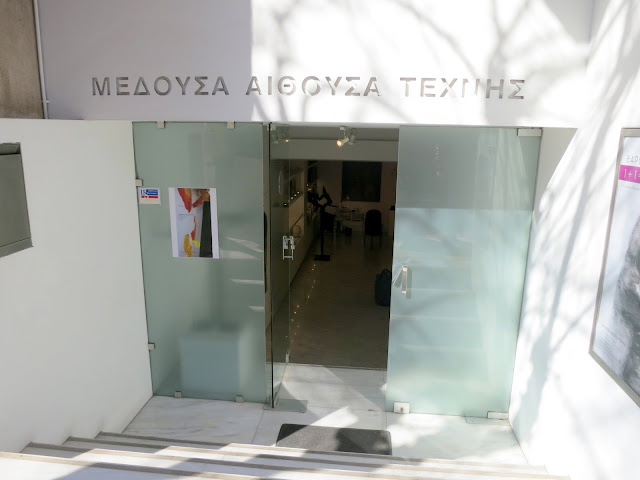Art and Resistance, 1950-1974,

at the Municipal Gallery, Athens.
This is a long post and yet, I have posted only a fraction of the works exhibited - by the time we got to the second building we were' arted-out' but this did not diminish our pleasure in this exhibition. A second visit would be advisable, but we have only two weeks left in Athens and there are still a lot of galleries and museums we want to visit.
Ismini Vogiatzoglou-Sklirou, Untitled, 1972 (mixed media)
Memas Kalogiratos, Untitled, 1972, (bronze)
Christos Karas, Exile, 1967, (oil on canvas)
This refers to the incarceration of political dissidents on barren rocks in the Aegean when conventional prisons could no longer cope with the number of political prisoners during the Greek Civil War in 1946-1949 and during the military junta in 1967-1974.
Valias Semertzidis, Imprisoned Men, 1967 (lithograph)
Dimitris Gioldasis, Jail, (oil on cardboard)
Kostas Malamos, The Day After, 1976, (oil on canvas)
This refers to the Athens Polytechnic Uprising in November 1973, an open anti-junta student revolt which resulted in bloodshed, 24 deaths and eventually led to the end of military rule in Greece.
Kostas Malamos, Vietnam, 1967, (oil on canvas)
Yannis Tsarouchis, Grief, 1951, (tempera on cardboard)
A. Tassos, Children of the Asphalt, 1974, (wooden print block)
A. Tassos, Slave, 1976, (wooden print block)
Vasso Kyriaki, Vietnam, 1968, (collage and acrylic)
Vlassis Caniaris, Untitled, 1969, (plaster, cloth, wood)
Yannis Psichopaidis, Demonstration, 1965-66, (lithograph)
Petros Zoumboulakis, Execution, 1967, (mixed media)
Yannis Stephanides, Girl Reading, 1977, (plaster)
Giorgos Dikeliotis, From Kalavryta to May Lai, (from the Vietnam series), 1965-70, (ink on paper)
Kostas Polychronopoulos, Execution, 1970, (iron and bronze)
Memos Makris, Old Greek Woman (Archondo Katsikaki), (from the Hungarian village of political refugees, 'Beloyannis') , 1951, (bronze)
Zizi Makri, Archondo Katsikaki, 1951, (from the Hungarian village of political refugees, 'Beloyannis'), (lithograph)
Orestis Kannelis, Presence, 1961-63, (oil on canvas)
Aris Papazoglou, The Kiss, 1973, (acrylic)
Vlassis Caniaris, Belt, 1970, (plaster, wire, metal)
Giorgos Kounalis, Girl with Dove, 1963, (oil on canvas)
Maria Ktistopoulou, Hiding Place, 1976, (mixed media)
Maria Ktistopoulou, Hiding Place 1, 1976, (acrylic on paper, wood, wire)
Maria Ktistopoulou, Hiding Place 2, 1976, (acrylic on paper, wood, wire)
Dimitris Talayannis, These Faces, 1976, (mixed media)
Anna Kindini, Makronissos, 1958, (print on plastic)
Makronissos is the infamous rock/island in the Aegean where political dissidents were incarcerated during the Greek civil war.
Anna Kindyni, Makronissos, 1958, (eau forte)
You can see more of her work
here
Anna Kindyni, Makronissos, 1958, (print on plastic)
 Anna Kindyni Makronissos, 1958, (print on plastic)
Anna Kindyni Makronissos, 1958, (print on plastic)
Anna Kindyni Makronissos, 1958, (print on plastic)
Yannis Hainis, Untitled, 1970, (mixed media on wood)
Aristides Patsoglou, Homme Opprime, 1970 (ceramic)
Yannis Parmakelis, Martyrs and Victims, 1973, (bronze)
Konstantinos Grammatopoulos, Heroes, 1957, (woodcut)
Dimitris Alithinos, Untitled, 1975
Christos Kapralos, Vietnam, 1966, (bronze)
Christos Kapralos, April 1967, (bronze)
This refers to the overthrow of Greek democracy by the colonels of the junta in 1967
Christos Kapralos, Vietnam VII, 1966, (bronze)
Dimitris Perdikides, Madrid 1976, (mixed media on wood)
Giorgos Argyrakis, Imprisoned Parthenon, 1970, (photo, collage)
Nikos Oikonomides, And you, Tortured People, do not Forget Oropos, 1972, (watercolour on paper)
A quote from one of Mikis Theodorakis' political songs
Dionysis Gerolymatos, Battle Between Centaurs and Students, 1973, (iron and bronze)
Dimosthenes Skoulakis, Days of 1967, 1970, (oil on canvas)
Dimosthenes Skoulakis, Greek Flag, 1967, (oil on canvas)
Thomas Molos, No More War, 1972, (oil on canvas)
Thomas Molos, Peace March, 1970
Thomas Molos, Mother 1 and 2, 1971, (oil on canvas)










































































































